- Faculty News
- Student News
- Lab News
- Publications
- Meetings and Presentations
- Outreach
- Grants
- Announcements
- About This Newsletter
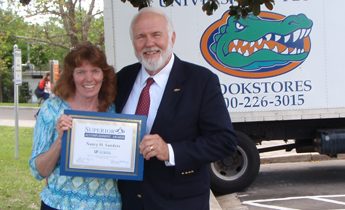
ABOVE: Ms. Nancy Sanders was one of the IFAS winners for the Superior Accomplishment Award. Thanks to Dr. Norm Leppla for helping recognize her accomplishments at the ceremony.
Please join us in congratulating the following CALS faculty and staff who were recognized on April 6 at the UF Faculty Awards Reception.
Dr. Rebecca Baldwin: Undergraduate Faculty Advising/Mentor Award
Dr. Andrea Lucky: Undergraduate Teaching Award
 Fulbright News
Fulbright News
Two of our scholars have been awarded the Fulbright grant for 2014-2015. The Fulbright grant is awarded through the Fulbright Program, the U.S. government’s flagship international educational exchange program.
Dr. James P. Cuda was awarded the grant to work on a field impact study of Calophya psyllids on the Brazilian peppertree during his time at the University of Blumenau, Santa Catarina in Blumenau, Brazil. “I'm absolutely stunned. I was notified on Christmas Eve, what a great present!” expressed Dr. Cuda when he received news he was a grant recipient. “The field study in Brazil will give us some real insight into what impact the psyllids will have on Brazilian peppertree when they are released in Florida,” stated Dr. Cuda in regards to what he hopes to accomplish after completing the study.
Dr. Phil Lounibos will also travel to the southern hemisphere thanks to his Fulbright award. He was awarded a grant to establish close collaborative links, and provide public and scientific seminars on the important field of invasive mosquitoes in Cairns and Brisbane, Australia. The program will allow him to engage with leading Queensland researchers in the field of mosquito control. “I hope to cross international borders to share new findings and knowledge that may contribute to public well being and decreased health risks,” stated Dr. Lounibos. Professor Lounibos is an entomology professor at UF/IFAS’ Florida Medical Entomology Laboratory (FMEL) in Vero Beach, Florida.

Almost 20 years after the introduction of Sentricon® in the market, Dr. Nan-Yao Su from the FLREC was inducted into the Florida Inventors Hall of Fame! Sentricon® revolutionized termite colony elimination systems and has protected millions of structures through a safer and greener approach to termite control.
 Dr. Christine W. Miller and four graduate students are teaching a new course this summer that is specifically for undergraduate students working in research labs on the topics of ecology, evolution, or behavior. Students will be learning presentation skills, about how their research fits within a broader context, and how science itself fits within our society and world. If you have student researchers who might be interested in joining us, please have them email Dr. Miller.
Dr. Christine W. Miller and four graduate students are teaching a new course this summer that is specifically for undergraduate students working in research labs on the topics of ecology, evolution, or behavior. Students will be learning presentation skills, about how their research fits within a broader context, and how science itself fits within our society and world. If you have student researchers who might be interested in joining us, please have them email Dr. Miller.
Dr. Christine W. Miller received a UFIC International Faculty Development Grant in March 2015. She will use it to travel to Australia this summer for an invited symposium presentation on the topic of Costs and Conflicts in Reproduction at Behaviour 2015: The International Ethological Conference. After the conference, she will travel north in Queensland to find tropical coreid species for a new project on insect weapon use and diversity.
 A note from Dr. John Capinera
A note from Dr. John Capinera
~Thanks to those of you who attended my retirement reception on February 17. The event, held at the Florida Museum of Natural History, went entirely too quickly, and though I tried to thank everyone who attended, I’m sure I missed a few of you due to the number of attendees.
I hope that you agree that the venue and refreshments were delightful, and the formal program mercifully short. The organizing committee did a wonderful job. I especially thank Clay Scherer, Glinda Burnett, Jane Medley, Dr. Faith Oi, and Dr. Jaret Daniels for their efforts in coordinating the event.
My 28-year tenure as department chair has been eventful and rewarding. I hope that I will be remembered for the positive outcomes during this period, though good things happen mostly when faculty and staff work together toward a common goal. Certainly many of the highlights of the past years (e.g., student enrollment increases, development of Distance Education programs, increased student endowments, increased faculty endowments, improved infrastructure for extension programs) reflect cooperative endeavors. Going forward, I hope that the Department can unite behind the new department chair to move the program to an even higher level of success.
~Dr. John Capinera
 Dr. Cory Stanley-Stahr’s research was featured in two short videos filmed for the Florida Museum of Natural History. The videos are Explore Research: Specialty Crop Pollinators and Why Science: Specialty Crop Pollinators.
Dr. Cory Stanley-Stahr’s research was featured in two short videos filmed for the Florida Museum of Natural History. The videos are Explore Research: Specialty Crop Pollinators and Why Science: Specialty Crop Pollinators.

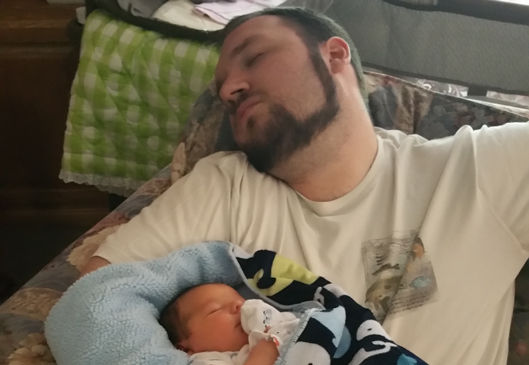
ABOVE: We would like to welcome Josh Gromoll to the Department. Josh has taken over for Steve Lasley who retired in March. Josh arrived on March 27th and his son Paul arrived on March 30th. When you get time please stop by Steve's old office and introduce yourself to Josh. We hope you will understand if he looks a little sleepy.
 The staff and students at the McGuire Center for Lepidoptera and Biodiversity have been planting butterfly gardens at local schools for over a year. The project can use your support. Click here for more information.
The staff and students at the McGuire Center for Lepidoptera and Biodiversity have been planting butterfly gardens at local schools for over a year. The project can use your support. Click here for more information.
 The American Chemical Society recognized Dr. Robert Vander Meer (a courtesy faculty member in our department) for his 50 years as a member. While serving in the Peace Corps (1972-1976) as Lecturer in Chemistry in The School of Natural Resources, University of the South Pacific, Suva, Fiji Islands, Vander Meer nurtured many of his first year class through to graduation four years later. During this time he exposed some of them to research as his assistants and for the majority of those interested in chemistry Dr. Vander Meer started the first American Chemical Society Student Chapter outside of the United States.
The American Chemical Society recognized Dr. Robert Vander Meer (a courtesy faculty member in our department) for his 50 years as a member. While serving in the Peace Corps (1972-1976) as Lecturer in Chemistry in The School of Natural Resources, University of the South Pacific, Suva, Fiji Islands, Vander Meer nurtured many of his first year class through to graduation four years later. During this time he exposed some of them to research as his assistants and for the majority of those interested in chemistry Dr. Vander Meer started the first American Chemical Society Student Chapter outside of the United States.
 Dr. James P. Cuda was a member of an Extension team that won the Association of Natural Resources Extension Professionals National Innovative Program Award. The Extension program that won the award was titled "Invasive Tropical Soda Apple Biological Control Extension Program for Ranches in St Lucie County, FL." Dr. William Overholt was the team leader.
Dr. James P. Cuda was a member of an Extension team that won the Association of Natural Resources Extension Professionals National Innovative Program Award. The Extension program that won the award was titled "Invasive Tropical Soda Apple Biological Control Extension Program for Ranches in St Lucie County, FL." Dr. William Overholt was the team leader.
 Congratulations to Dr. Jim Maruniak for being named Club Advisor of the Year from the Student Activities Involvement Team. Dr. Maruniak has advised the Virology Club since 1998. Other nominations from our department's Entomology Club included Stefani Harrison as Club Member of the Year, Kristen Donovan as Club Officer of the Year, Dr. Rebecca Baldwin as Club Advisor of the Year and BugFest as Event of the Year. The awards ceremony was April 9th in the Reitz Union Grand Ballroom and had a masquerade theme.
Congratulations to Dr. Jim Maruniak for being named Club Advisor of the Year from the Student Activities Involvement Team. Dr. Maruniak has advised the Virology Club since 1998. Other nominations from our department's Entomology Club included Stefani Harrison as Club Member of the Year, Kristen Donovan as Club Officer of the Year, Dr. Rebecca Baldwin as Club Advisor of the Year and BugFest as Event of the Year. The awards ceremony was April 9th in the Reitz Union Grand Ballroom and had a masquerade theme.
 In March, Dr. Roberto Pereira took a 2-week trip (Mar 13 to Mar 28) to Brazil where he participated in the following activities:
In March, Dr. Roberto Pereira took a 2-week trip (Mar 13 to Mar 28) to Brazil where he participated in the following activities:
Mariah Baggio’s defense (Mariah stayed for 6 months in our lab here at UF through the program Science Without Borders - Ciência Sem Fronteiras, that Brazil has to encourage researchers to get experience outside of the country), Dr. Roberto Pereira's participation in the defense was as an outside member of her defense committee. Ph.D. defense committees at the University of the State of São Paulo (UNESP)-Jaboticabal, where Mariah got her degree, are required to have two invited members from outside the university + two from the department + the student advisor.
Presented the opening lecture of the VI Course in Domisanitary Treatments (VI Curso de Tratamento Domissanitário), a biannual meeting promoted by the UNESP- Jaboticabal for folks involved in the Pest Management Industry in Brazil. The lecture was entitled “Research and Development of Techniques for Urban Pest Management” in which he discussed the education and research we do here at UF.
Presented two sections of a 2-hour short course on Pest Ant Biology and Identification as part of the VI Curso de Tratamento Domissanitário.
Offered a 30 hour graduate-level course on Urban Entomology including lectures on pest ants, cockroaches, termites, flies, bed bugs and their control. This was the second time Dr. Roberto Pereira taught this course at UNESP. Mariah Baggio helped with a couple of lectures, and they had five registered students.
Please join us in congratulating the following Entomology and Nematology majors and minors who have been awarded a University of Florida Entomology and Nematology Department Travel Scholarship for 2015.
Funds for this scholarship are made available through donations from faculty members and former faculty members who wish to promote undergraduate research. The fund is an endowment known as the Book Fund Scholarship.
- Ms. Stefani Harrison - $400 for travel to work with type specimens at the Smithsonian in Washington, DC.
- Mr. Mason Russo - $400 for study abroad in New Zealand (Sustaining Humans and their Environments).
- Ms. Johnalyn Gordon - $400 for travel to Arizona as a field assistant for a butterfly research project.
- Mr. Grayson McWhorter - $200 for travel to the Florida Entomological Society meeting to present undergraduate research in evolutionary ecology.

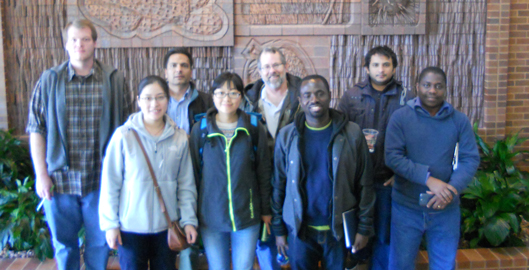
ABOVE: Over spring break Dr. Billy Crow took the Field Plant Nematology class on a 1-week field trip focused on careers in the Agrichemical Industry. They visited the research facilities of DuPont Crop Protection in Newark Delaware, the U.S. research facilities of Syngenta Crop Protection in Greensboro and Raleigh NC, the U.S. research facilities of Bayer CropSciences in Morrisville and Raleigh NC, the U.S. research facilities of BASF in Raleigh NC, and the U.S. headquarters of Adama in Raleigh NC.
The students learned about all aspects of crop protection including pesticide discovery, pesticide development, gene discovery, biotech, formulation, packaging, seed treatment, environmental fate, patents, and marketing. They met with potential employers, including CEO's who gave them advice on career preparation, CV writing, and interviewing. They also were very well hosted and well fed by the sponsors.
 Congratulations to Ms. María Cristina Carrasquilla, Entomology and Nematology Ph.D. student at the Florida Medical Entomology Laboratory for winning first prize in the student research competition of the American Mosquito Control Association. Her talk entitled "Sterilization without insemination of Aedes aegypti by invasive Aedes albopictus" won the annual Gerald Hollandsworth prize that includes a $2,000 cash award. Maria Cristina is co-advised by Dr. L. Philip Lounibos and
Dr. Jorge R. Rey of FMEL.
Congratulations to Ms. María Cristina Carrasquilla, Entomology and Nematology Ph.D. student at the Florida Medical Entomology Laboratory for winning first prize in the student research competition of the American Mosquito Control Association. Her talk entitled "Sterilization without insemination of Aedes aegypti by invasive Aedes albopictus" won the annual Gerald Hollandsworth prize that includes a $2,000 cash award. Maria Cristina is co-advised by Dr. L. Philip Lounibos and
Dr. Jorge R. Rey of FMEL.
 Congratulations to Ms. Maria Fernanda Checa Villafuerte, doctoral candidate, who was recognized at The 18th Annual Women’s History Month Award Celebration. Maria was one of 8 finalists for the two graduate student awards presented by the UF Association for Academic Women.
Congratulations to Ms. Maria Fernanda Checa Villafuerte, doctoral candidate, who was recognized at The 18th Annual Women’s History Month Award Celebration. Maria was one of 8 finalists for the two graduate student awards presented by the UF Association for Academic Women.

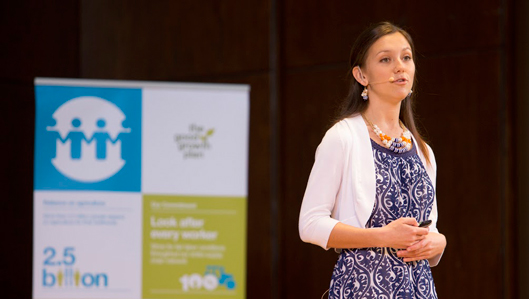
ABOVE: Congratulations to Ms. Casey Parker, M.S. student in Entomology and Nematology, for bringing home the Grand Prize at the One World event sponsored by Syngenta and the Challenge 2050 Project. Casey received a $1500 award for her presentation on a novel mosquito trap that has the potential to dramatically reduce transmission of mosquito-borne diseases.
 The Miller Lab is proud to host an excellent team of six undergraduate researchers for the summer. Among these students, M. Grayson McWhorter is embarking on independent study as part of the UF University Scholars Program, Jamie Capps is working as part of the UF/IFAS Summer Internship Program, and Tyler Herrington is joining us as part of the UF-HHMI Science for Life intramural research program. The students will all be directly mentored by graduate students in the lab and Dr. Christine W. Miller.
The Miller Lab is proud to host an excellent team of six undergraduate researchers for the summer. Among these students, M. Grayson McWhorter is embarking on independent study as part of the UF University Scholars Program, Jamie Capps is working as part of the UF/IFAS Summer Internship Program, and Tyler Herrington is joining us as part of the UF-HHMI Science for Life intramural research program. The students will all be directly mentored by graduate students in the lab and Dr. Christine W. Miller.
 Ms. Brittany Campbell won first place in the scientific poster competition at PestEx 2015, held by the British Pest Control Association in London, March 25th-26th, 2015. Her poster was titled "Insecticide resistance in bed bug, Cimex lectularius, eggs and first instars."
Ms. Brittany Campbell won first place in the scientific poster competition at PestEx 2015, held by the British Pest Control Association in London, March 25th-26th, 2015. Her poster was titled "Insecticide resistance in bed bug, Cimex lectularius, eggs and first instars."
 Mr. Eutychus Kariuki, a Ph.D. student in the laboratory of Dr. James P. Cuda, attended the 2015 College of Agriculture and Food Sciences Research Forum held at Florida A&M University, Tallahassee, FL, 31 March. Mr. Kariuki was the First Place Winner for a Graduate Student Oral Presentation titled "Host specificity of a potential hydrilla biological control agent, Cricotopus lebetis Sublette (Diptera: Chironomidae), in Lakes Rowell and Istokpoga."
Mr. Eutychus Kariuki, a Ph.D. student in the laboratory of Dr. James P. Cuda, attended the 2015 College of Agriculture and Food Sciences Research Forum held at Florida A&M University, Tallahassee, FL, 31 March. Mr. Kariuki was the First Place Winner for a Graduate Student Oral Presentation titled "Host specificity of a potential hydrilla biological control agent, Cricotopus lebetis Sublette (Diptera: Chironomidae), in Lakes Rowell and Istokpoga."

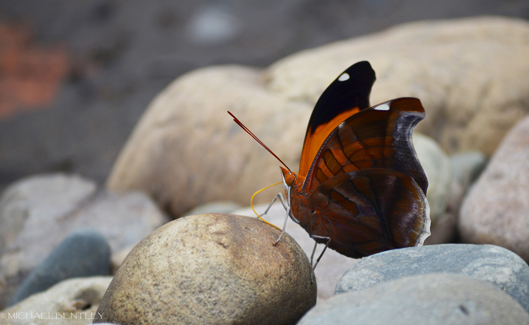
ABOVE: Mr. Mike Bentley was awarded Honorable Mention for his photo “Afternoon Drink” in the Elegance of Science Art Contest organized by the Marston Science Library and the Florida Museum of Natural History. The Elegance of Science Art Contest emphasizes and facilitates the link between artistic and scientific perceptions of reality. .
Need to name that bug? A host of experts are available to help Floridians identify any insect or related arthropod. If a mystery creature has six or more legs, the UF Insect ID Lab is the place to call.
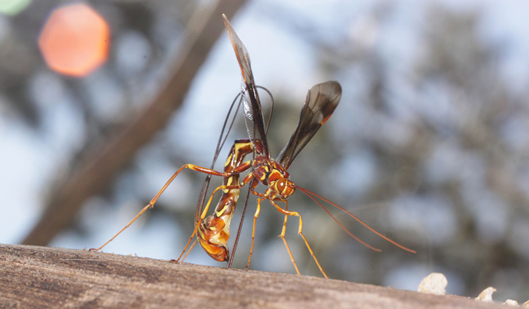
ABOVE: Andrei Sourakov took this great photo in NATL and provided this description. This species, Megarhyssa macrurus (Ichneumonidae), is one of the world's largest parasitic wasps. By detecting vibration in the wood, Megarhyssa finds its host, a larva of the Pigeon horntail (Tremex columba), a xylophagous wasp of the family Siricidae, which bores tunnels in decaying wood. Megarhyssa injects its egg into its host together with a symbiotic virus that helps to overcome the host's immune response.
Lyle Buss is the Insect ID Lab manager.
 Think it might be a nematode problem? The Nematode Assay Laboratory serves Florida and other states by providing nematode assays and expert advice regarding nematode management.
Think it might be a nematode problem? The Nematode Assay Laboratory serves Florida and other states by providing nematode assays and expert advice regarding nematode management.
For more information on the Nematode Assay Laboratory please contact the lab manager Dr. Tesfa Mengistu.
Alto BW, Bettinardi DJ, Ortiz S. 2015. Interspecific larval competition differentially impacts adult survival in dengue vectors. Journal of Medical Entomology. 52: 163-170. News release associated with this paper.
Cao R, Su NY. 2014. Tunneling and food transportation activity of four subterranean termite species (Isoptera: Rhinotermitidae) at various temperatures. Annals of the Entomological Society of America. 107(3): 696-701.
Carnohan LP, Kaufman PE, Allan SA, Gezan SA, Weeks ENI. 2015. Evaluation of four bed bug traps for surveillance of the brown dog tick (Acari: Ixodidae). Journal of Medical Entomology. 52: 260-268 DOI: http://dx.doi.org/10.1093/jme/tju020.
Chouvenc T, Basille M, Li HF, Su NY. 2014. Developmental instability in incipient colonies of social insects. PloS one, 9(11), e113949.
Chouvenc T, Basille M, Su NY. 2015. The production of soldiers and the maintenance of caste proportions delay the growth of termite incipient colonies. Insectes Sociaux. 62: 23-29.
Chouvenc T, Helmick EE, Su NY. 2015. Hybridization of two major termite invaders as a consequence of human activity. PLoS ONE, 10(3), e0120745. See "Entomology April’s fool. Not on purpose, though" below for how this paper was reported by the popular press.
Chouvenc T, Mullins AA, Su N-Y, 2015. Territorial status-quo between the big-headed ant (Hymenoptera: Formicidae) and the Formosan subterranean termite (Isoptera: Rhinotermitidae). Florida Entomologist. 98: 157-161.
Chouvenc T, Su NY. 2014. Colony age-dependent pathway in caste development of Coptotermes formosanus Shiraki. Insectes Sociaux. 61(2): 171-182.
Fulcher A, Farooq M, Smith ML, Li CX, Scott JM, Thomson E, Kaufman PE, Xue RD. 2015. Evaluation of a new spraying machine for barrier treatment and penetration of bifenthrin-barrier spray on vegetation against mosquitoes. Journal of the American Mosquito Control Association. 31: 85-92. DOI: http:/dx.doi.org/10.2987/12-6424R.1
Kaufman PE, Wood LA. 2015. Discovery and successful development of Cuterebra americana (Diptera: Oestridae) from an atypical host, Rattus rattus (Rodentia: Muridae), in Florida, U.S.A. Florida Entomologist. 98: 349-351.
Kumar V, Xiao YF, McKenzie CL, Osborne LS. 2015. Predator-In-First: Early establishment of the phytoseiid mite Amblyseius swirskii (Acari: Phytoseiidae) on pepper seedlings in a Predator-In-First approach. Experimental and Applied Acarology. 65: 465-481.
Li CX, Smith ML, Fulcher A, Kaufman PE, Zhao TY, Xue RD. 2015. Field evaluation of three commercial light traps against two standard light traps to collect mosquitoes and non-target insects in northeast Florida. Florida Entomologist. 98: 114-117.
McGaha TW Jr, Young RM, Burkett-Cadena ND, Iburg JP, Beau JM, et al.
2015. Identification of communal oviposition pheromones from the black fly Simulium vittatum. PLoS ONE 10(3): e0118904. doi:10.1371/journal.pone.0118904.
Smith M, Hendrix B, Su NY, Quisenberry SS, Hendrix WH, Mankin RW, Kuniyoshi CH. 2014. Instant Symposium—Connecting with the world's best talent: Attracting and retaining diverse entomologists. American Entomologist. 60(3): 146-159.
Steininger MS, Hulcr J, Sigut M, Lucky A. 2015. Simple and efficient trap for bark and ambrosia beetles (Coleoptera: Curculionidae) to facilitate invasive species monitoring and citizen involvement. Journal of Economic Entomology. DOI: http://dx.doi.org/10.1093/jee/tov014. News release associated with this paper.
Su NY. 2014. Tokoyo no Kami: A caterpillar worshipped by a cargo cult in ancient Japan. American Entomologist. 60(3): 182-188.
Su NY. 2015. A fluid bait for remedial control of subterranean termites. Journal of Economic Entomology. 108(1): 274-276.
 New on Featured Creatures:
New on Featured Creatures:
Australian cockroach, Periplaneta australasiae Fabricius Authors: Shiyao Jiang and Phillip E. Kaufman, Entomology and Nematology Department, University of Florida.
vespiform thrips, Franklinothrips vespiformis Crawford Authors: Runqian Mao, Yingfang Xiao, and Steven P. Arthurs, Entomology and Nematology Department, University of Florida.
coconut scale, Aspidiotus destructor Signoret Authors: Salahud din and Steven P. Arthurs, Entomology and Nematology Department, University of Florida.
Do you have a favorite creature? Learn how to make it into a Featured Creatures!
The Southeastern Branch of ESA had its annual meeting March 15-18 in Biloxi, Mississippi. As the Florida representative of the Student Affairs Committee for ESA, Lindsy Iglesias helped organize the Insect Photo Salon for the 2015 meeting. We had in increase in participation with double the number of photos submitted to the five different categories. This year we will begin displaying the winning photographs of the Insect Photo Salon on the ESA website and in the eNews following the meeting.
Please consider submitting your photos for next year. The call for photos will be sent in early 2016. Thanks to all who participated.

Burkett-Cadena, ND. Winter transmission of eastern equine encephalitis virus in Florida. Venue: The 12th Arbovirus Surveillance and Mosquito Control Workshop. Sponsored by Anastasia Mosquito Control District & USDA/CMAVE St. Augustine, Florida, March 24-26, 2015.
 Dr. James P. Cuda attended the 89th Annual Meeting of the SEB-ESA held in Bilox, MS, 15-18 March. Cuda participated in the S-1058 Biological Control of Arthropod and Weed Pests Symposium, where he gave a presentation titled, “Recent advances in biological control of Brazilian peppertree, Schinus terebinthifolia. The presentation was co-authored by Dr. William Overholt.
Dr. James P. Cuda attended the 89th Annual Meeting of the SEB-ESA held in Bilox, MS, 15-18 March. Cuda participated in the S-1058 Biological Control of Arthropod and Weed Pests Symposium, where he gave a presentation titled, “Recent advances in biological control of Brazilian peppertree, Schinus terebinthifolia. The presentation was co-authored by Dr. William Overholt.

From the Outreach Coordinator
A big thank you to the students and faculty who volunteered at our February and March outreach events.
- 5-16 February- Florida State Fair. The State Fair was a big success, thank you to everyone who helped out.
- 10 February- YOPP Inc. Homeschool Group. Participants: Oliver Keller, Erin Powell.
- 18 February- UF Majors and Minors Fair. Participants: Ruth Brumbaugh, Dr. Rebecca Baldwin, Erin Powell.
- 26 February- Glen Springs Elementary School Science Night. Participants: Teddy Cogley, Erin Powell.
- 27 February- Greenhouse Church Homeschool Group. Participants: Johnalyn Gordon, Erin Powell.
- 10 March- Oak Hall High School. Participants: Kristen Donovan and Erin Powell.
- 11 March- Micanopy Area Cooperative School. Participants: Erin Powell.
- 12 March- Duval Elementary Afterschool Program. Participants: Sam Pass, Evan Waite, Cindy Siegler, and Erin Powell.
- 23 March- Ambleside Middle School. Participants: Erin Powell and Kristen Donovan.
- 25 March- Homeschool Group. Participants: Erin Powell and Heather Erskine.
- 27 March- Micah Homeschool Group. Participants: Dale Halbritter, Johnalyn Gordon, Heather Erskine, Jeff Coco, Natalie Grand Bois, Shari Linn, Thomas Bevelock, Erin Powell.
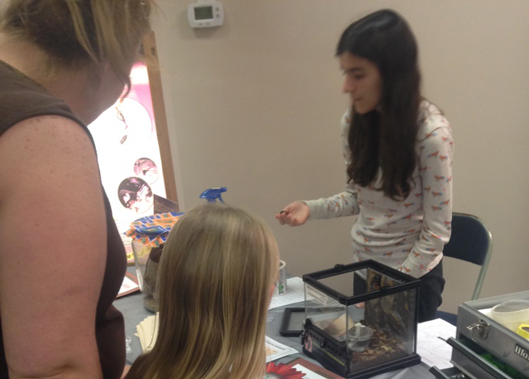
ABOVE: Gabriella Steele introduces some fair-goers to one of our roaches. The hissing cockroaches were a huge hit at the State Fair.
Upcoming events:
- 17 April- Queen of Peace Academy
- 17 April- Archer Elem. Carnival
- 25 April- Girl Scouts Troop
- 29 April- Pre-K group visit
We have many upcoming events and need volunteers to make these possible! Please contact Erin if you are available to volunteer.
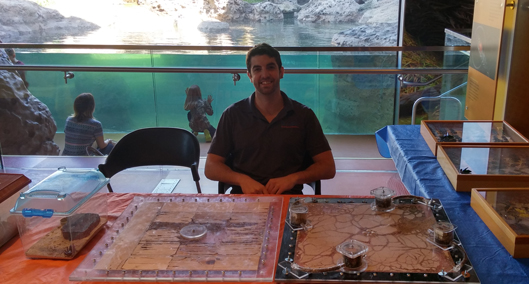
ABOVE: Lucas P. Carnohan volunteered at the Museum of Discovery and Science in Ft. Lauderdale, FL.
The live critters are always a hit with children and adults alike. The critters are available for you to check out should you be leading an outreach event. We have doubles of our most popular critters, as well as various native insect species depending on the time of year. We have large wood and Plexiglas cages for viewing our native orb weaving spiders. There is one travel cage and one larger static cage. Please be sure to contact us and review the protocol on transporting and handling the critters if you are not already familiar with it. If you lead an outreach, be sure to fill out a documentation form so your event can be included in the newsletter and we can log all outreach events.
If you have any questions please email me.
Thank you — Erin Powell, Outreach Coordinator.
If you would like to schedule an event or have any outreach questions, go to the Outreach pages on our Bug Club Website and contact us.
 Getting social!
Getting social!
We have several social media sites for the Entomology & Nematology Department. To make them easily searchable, all three (YouTube, Facebook and Twitter) have the same page name: UFEntomology. Please share these links with past students or colleagues who may have an interest in departmental activities.
Virni Mattson, our grants specialist, reports that from March 1st to March 31st, 2015, we have had six new grants or contracts awarded for a total of $310,459.88 in external funding for all Entomology & Nematology faculty (in Gainesville and at RECs).
FES Honors and Awards 2015
The Florida Entomological Society Honors and Awards Committee are requesting nominations for 2015 in the following categories:
- Entomologist of the year.
- Annual Achievement Award for Research.
- Annual Achievement Award for Extension.
- Annual Achievement Award for Industry.
- Annual Achievement Award for Teaching.
- Annual Achievement Award for Regulatory Entomology.
- Achievement Award for a Collaborative Research Team.
Winners will be announced at the 2015 Annual Meeting. Each nomination should be accompanied with a justification narrative that will be read at the awards luncheon. View previous winners.
Nomination deadline is July 1, 2015.
Nominations should be emailed to: Dr. Jawwad Qureshi
Chair, Honors and Awards Committee
University of Florida-IFAS-SWFREC
Phone: 239-658-3451
 Entomology April’s fool. Not on purpose, though
Entomology April’s fool. Not on purpose, though
Guest article by Dr. Thomas Chouvenc
The past few weeks were interesting. The recent publication about termite hybridizing in south Florida, published by the Su Lab, receive extensive media attention, and while the press release was very well crafted by IFAS Communication, the mass media did what it usually does: exaggerate. Just a bit.
Chouvenc, T., E.E. Helmick, and N.-Y. Su. 2015. Hybridization of two major termite invaders as a consequence of human activity. PloS one 10: e0120745 is a paper explaining the potential for hybridization between two termite invaders and we took the time to carefully look at the data to make our statement in the original publication. Was it because of climate change? We don’t know yet, the data is too little (although it was a very warm year!). Is it fully established yet in Florida? We don’t know, we only have lab colonies so far. Are hybrid colonies developing exponentially fast? Well, look at the sample size, we still have much more to do to confirm. Are we all going to die? “-sigh-”
Despite the caution we expressed, the temptation was too good to pass on such occasion. It only took a few hours for the news to go viral, with a gradual deterioration of the accuracy of the information as it spread over the internet. Unleash the beast; you have no control over it.
So we sat. And we watched. And we laughed.
What else could we do after all? It was all a bit foolish but, how appropriate for this time of the year?!
It started smoothly:
“Termite species mate, creating new menace”
“Hybrid Super-Termites Could Emerge From Interspecies Swarms”
“ 'Super-Termite' Could Be Even More Destructive Than Parent Species”
Then things got a little weird:
“2 Exotic Termites Find Love in Florida, Worrying Researchers”
“2 Ruinous Termite Species Have Mated in Florida”
“Termites in Cahoots swarm Florida”
“Two Termite Species Fall In Love And Give Birth To Super Termites”
And weirder:
“Invasive termites in Florida are cross-breeding into terrifying new species of “Super Termites”
“A new study is the latest sign that climate change is going to affect us in strange and horrible ways”
“New turbo termite living in Florida”
“Deadly termite superswarms form in South Florida:
Andà “Humanity likely doomed by new hybrid termites found in Florida” ß
And come with this my two favorite quotes
“Two particularly hungry, exotic termite species apparently have found love halfway around the world and, as with so many other Florida hook-ups, the results are disturbing.”
“According to University of Florida entomologists, climate change has gotten so screwy that weather patterns are making the swarming seasons of the two most destructive termite species on the planet crash into each other, and it's turning into one large termite orgy.”
It was all good fun. After all, sensationalism has become a norm in this day and age, and it was all very expected. However, can we go back to the science now?
Video: A narrated story of our study for the media.
Video: The spectacular swarms a couple of weeks ago in Ft. Lauderdale, with exclusive image from the mating behavior between the two species.
Video: A UF interview that is currently on the UF front page.
 2015 Southeast Pest Management Conference
2015 Southeast Pest Management Conference
We are about a month from the 2015 Southeast Pest Management Conference, here at the University of Florida in Gainesville. This will be the 20th edition of our favorite meeting.
For this special edition of the SEPMC, we have invited some important personalities in the pest management world to help us commemorate the 20th anniversary of our conference. All speakers on Monday and Tuesday are UF Alumni who made it big in the world of pest management.
We will have:
- a full day (5 CEU's) of GHP on Monday, plus 2 CORE CEU's.
- a full day (5 CEU's) of WDO on Tuesday, plus 2 CORE CEU's.
- a full day (5 CEU's) of L&O on Wednesday, plus 2 CORE CEU's.
- a separate 2-CEU's track on Fumigation on Tuesday
As usual, Master Gardeners and State employees are invited for the conference free of charge. All you need to do is go to the SEPMC website and follow the link to the Eventbrite site to register. State Employees and Master Gardeners should chose the right registration category to enjoy the free registration.
 Postdoctoral research opportunity for Chemical Ecologist, Molecular Biologist, Entomologist or combination thereof
Postdoctoral research opportunity for Chemical Ecologist, Molecular Biologist, Entomologist or combination thereof
This project deals with invasive pest ants. The successful applicant will work with a research team that conducts basic and applied research to elucidate invasive pest ant behavior, semiochemicals, and key biosynthetic pathways through bioassay development, chemical analysis, and molecular techniques. The long-term objective is to use this information to develop novel biologically based surveillance/control methods for invasive pest ants.
The position is funded by USDA/ARS through Oak Ridge Institute for Science and Education (ORISE) and managed by Oak Ridge Associated Universities (ORAU).
The position is located in Gainesville, FL at the Center for Agricultural, Medical and Veterinary Entomology (CMAVE) and within the Imported Fire Ant and Household Insects Research Unit. The annual stipend for the position is $48,403. For specifics about this position and how to apply go to the ORAU website.
For questions and/or details about potential projects contact: Robert Vander Meer, 352-374-5855.
We like to share news when it happens using our social media outlets: Twitter, Facebook and YouTube. Follow us on these sites for daily updates! When you send news, we will post it on one or more of these sites and again in the monthly newsletter. Please be sure you have permission from people in photographs you submit for publication.
UF-Bugnews-L listserv subscribers receive notices when issues are posted. Our home page has instructions for subscribing and unsubscribing.
Special thanks to Haleigh Ray and Nancy Sanders, who reviewed the newsletter for errors, and to Jane Medley and Don Wasik, who built the web page design.